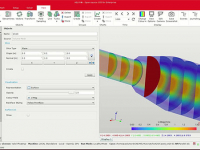
September 1, 2019
THE ERA OF SIMULATION applications is here. Tools are available for the rapid development and unlimited distribution of applications worldwide. Forward-thinking companies are taking the lead on democratizing simulation.
Q: Why do companies start using simulation applications?
A: Mathematical modeling and numerical simulation are ubiquitous tools for product development that have been around for more than half a century. However, the use of these tools has been restricted to simulation engineers. As the go-to persons for providing critical engineering analysis for an entire organization, they may become a bottleneck for maximizing the value of simulation. By creating easy-to-use simulation applications and distributing them throughout the organization, companies can now fully take advantage of the power of simulation, as employees without any experience with modeling can use applications. One example is Cornell Dubilier, a leader in manufacturing high-quality capacitors, which creates applications for the optimization of their electrical properties. Their research director, Sam Parler, comments that “[we] create applications for other departments to let them test different design configurations for their particular requirements and pick the best one.”
Q: What is the role of simulation engineers in democratizing simulation?
A: Simulation engineers are the key to democratizing simulation. The creation of specialized applications is based on the computational models they develop. Applications enable anyone to test parameters and run repeated analyses without simulation expertise. The simulation engineer can instead focus on solving complex problems, developing innovative simulations, and building more applications. For instance, Samsung Audio Lab — a leading manufacturer of audio equipment — brings together multiple engineers to design high-quality loudspeakers using simulation and their applications.
Download this doc to read the rest of this Q&A.
Latest News







